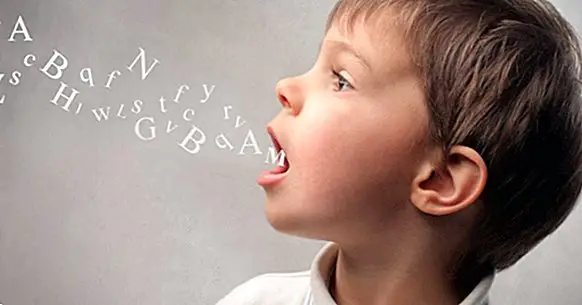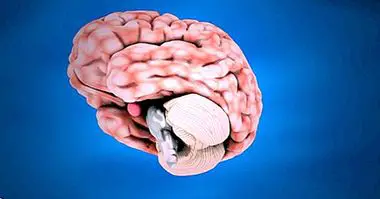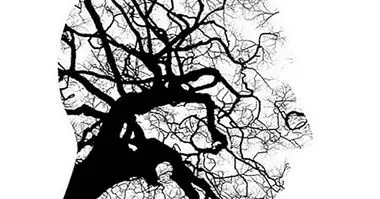Echolalia: what it is, causes and related disorders
The alterations and injuries that affect the cerebral structures involved in the language, in the imitative behaviors and in the inhibition of the behavior can cause the symptoms that we know as echo phenomena, consisting in repeating movements or words that the person has seen or heard previously.
One of these symptoms is echolalia, in which words or phrases are imitated. In this article we will describe what is echolalia, what are its most common causes and to what psychological and medical disorders is normally associated.
- Maybe you're interested: "The 16 most common mental disorders"
What is echolalia?
The term "echolalia" is used to refer to the involuntary repetition of words spoken by other people . It is a characteristic symptom of different psychological disorders, both organic and functional, such as autism, aphasia and schizophrenia.
The repetition can consist of a single word or, on the contrary, in very prolonged messages; Sometimes not only words or phrases are repeated, but monologues, conversations or entire songs. When the person imitates herself instead of others we talk about palilalia.
The echolalia it's an eco-phenomenon , that is, an imitative behavior that occurs without conscious control. Two other very common ecphenomena are echopraxia, in which actions or gestures of others are repeated, and ecomimia, consisting of the imitation of facial expressions.
Types of echolalia
The symptoms of echolalia are classified according to two criteria: the latency of the response (that is, the time it takes for the repetition to appear) and the intentionality of the behavior. So, we can talk about immediate or delayed echolalia and functional or non-functional echolalia .
Immediate echolalia, as its name suggests, occurs just after the person hears the vocalization. Delayed echolalia can occur at any time, there sometimes being a temporary distance of years between the original verbalization and imitation.
Following the criterion of intentionality, we divide the ecolálicas manifestations into functional ones, when the person has a communicative intention or self-regulation , and not functional, if the above conditions are not met.
Causes of this phenomenon
Imitative behavior, including echolalia, It is normal and adaptive in boys and girls , since they use it to acquire and internalize new behaviors. However, as the language develops and the child learns cognitive self-regulation skills, this phenomenon becomes less common.
After 3 years, echolalia may be a sign that there is an underlying disorder that affects the progress of language or behavioral inhibition; in this way, echolalia often appears in blind children , with learning difficulties or with a generalized developmental disorder.
Echolalia in adults is generally considered pathological because it tends to be a manifestation of brain injuries; is particularly associated with damage to the frontal lobe of the left hemisphere caused by genetic factors, traumatisms, cerebrovascular accidents or other causes.
In this sense, the supplementary motor area and the medial part of the frontal lobe appear to have special relevance. The role of so-called "mirror neurons" has also been highlighted, which are triggered when we imitate the behavior of others, both externally and in the imagination.
Related disorders
There are many disorders that alter the functioning of language and behavioral inhibition and that therefore are likely to cause echolalia. Next we will briefly describe the alterations that are associated with this phenomenon in a more usual way.
1. Autistic spectrum
The concept "autistic spectrum disorders", which was introduced in the DSM-5, includes Asperger syndrome, childhood disintegrative disorder and Rett syndrome, as well as Kanner's own autism and other pervasive developmental disorders.
This set of syndromes is probably due to dysfunctions in mirror neurons derived from genetic causes . Autistic spectrum disorders affect communication, social interaction and the breadth of the behavioral repertoire, and in many cases they have intellectual deficits.
Within the framework of autism, the type of echolalia may vary depending on the intensity of the alterations and the specific situation. Thus, non-functional echolalia is more likely to occur in autistic people who do not understand speech, while functional speech can be used to compensate for linguistic difficulties. In these cases, immediate echolalia is common.
- Related article: "Autism Spectrum Disorders: 10 Symptoms and Diagnosis"
2. Tourette syndrome
Tourette syndrome is characterized by chronic and simultaneous presence of motor and vocal tics . One of the most well-known symptoms of Tourette's syndrome is coprolalia, which consists in the impulsive emission of obscene or socially incorrect words, although it only occurs in approximately 10% of cases.
Similarly, although they are less frequent than coprolalia, echophenomena such as echolalia and echopraxia also occur in the context of this disorder. Palilalia is another possible symptom of Tourette syndrome.
3. Aphasia
Injuries due to strokes or traumatic brain injuries often cause aphasia, a set of language disorders associated with brain damage. In these cases the echolalia usually has a compulsive and non-functional character .
Echolalia is particularly common in transcortical sensory aphasia, which occurs as a consequence of lesions in the temporal lobe. In addition to echolalia, other characteristics of this type of aphasia are the presence of paraphasias (substitution of words for incorrect ones) and the maintenance of verbal comprehension.
4. Dementia
Dementias are neurodegenerative diseases that cause a progressive loss of cognitive faculties, especially memory. When the lesions affect the brain regions involved in language and self-regulation, they can cause echolalia symptoms similar to those of aphasia.
The echolalia is especially usual in frontotemporal dementias , especially in Pick's disease. Degenerative disorders affecting the basal ganglia, such as Parkinson's disease, Huntington's disease and progressive supranuclear palsy, also frequently cause ephphenomena.
- You may be interested: "Types of dementia: forms of cognition loss"
5. Schizophrenia
The DSM-IV defines schizophrenia as a chronic disorder characterized by the presence of hallucinations, delusions, disorganized language and / or affective flattening, among other symptoms.
One of the subtypes of schizophrenia is the catatonic , which implies alterations due to excess or defect in the movement. Echolalia and echopraxia are common in catatonic schizophrenia.
- Related article: "The 6 types of schizophrenia and associated characteristics"




















